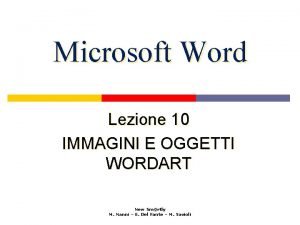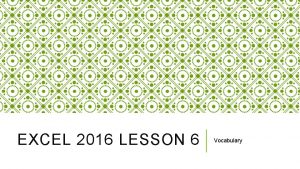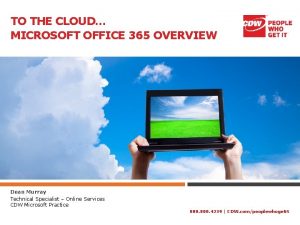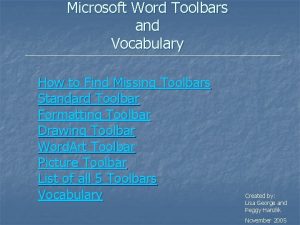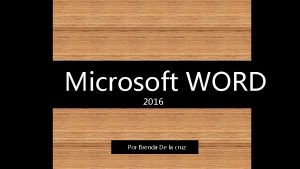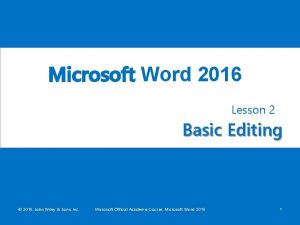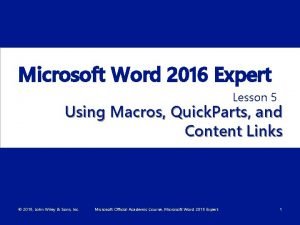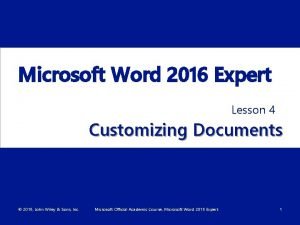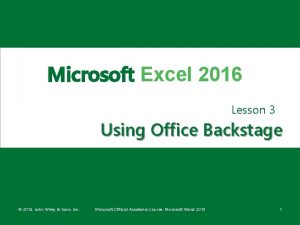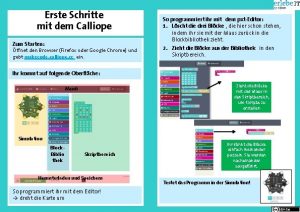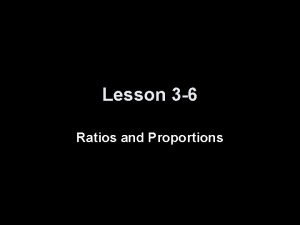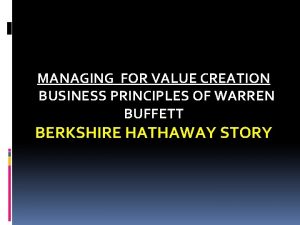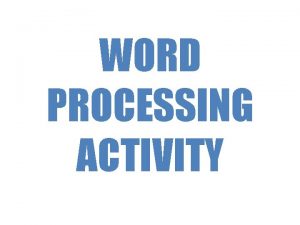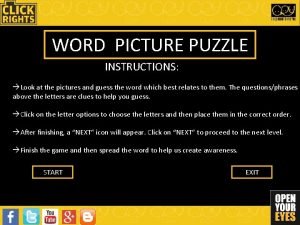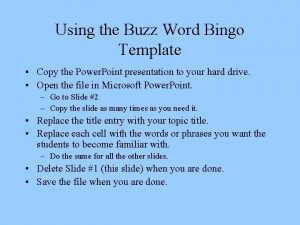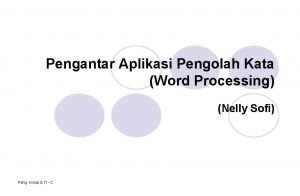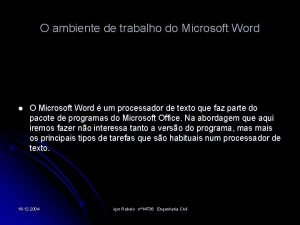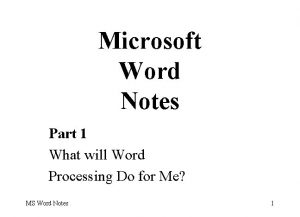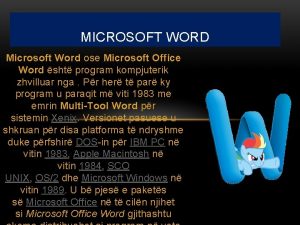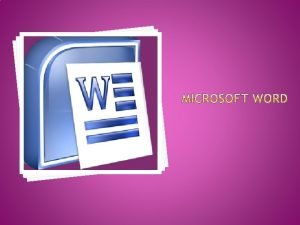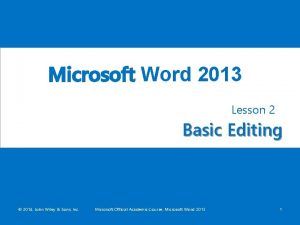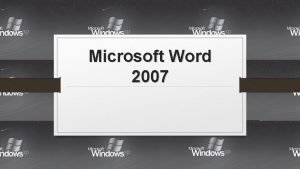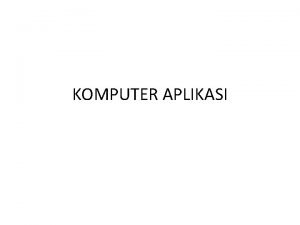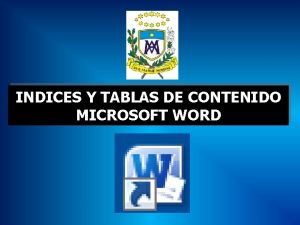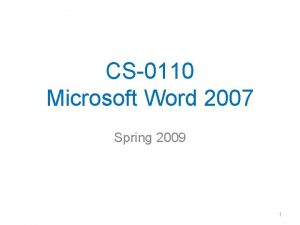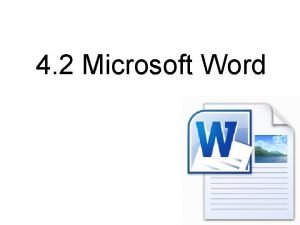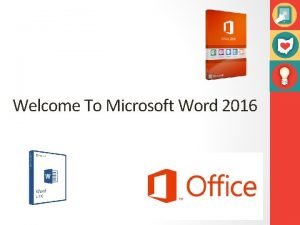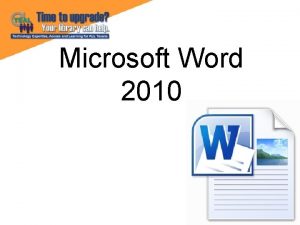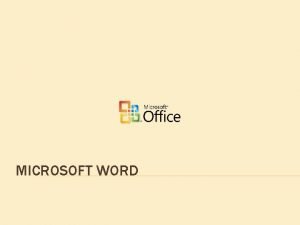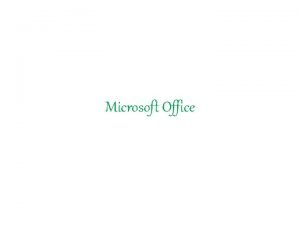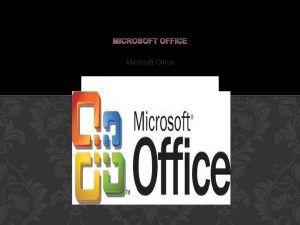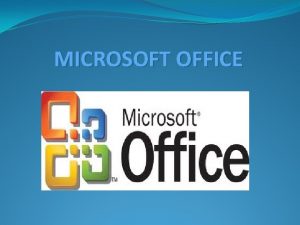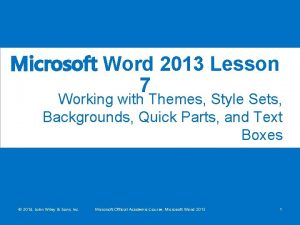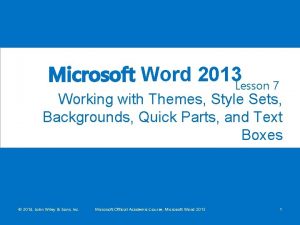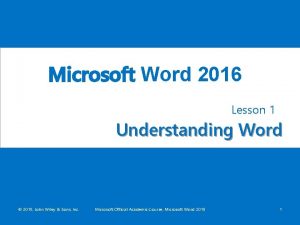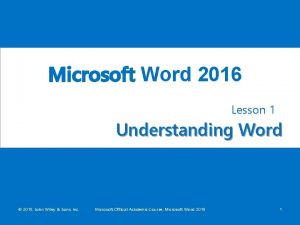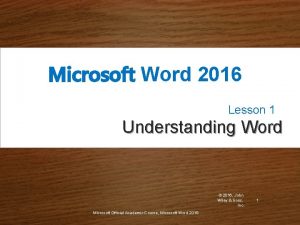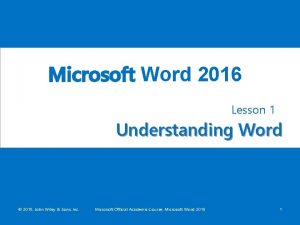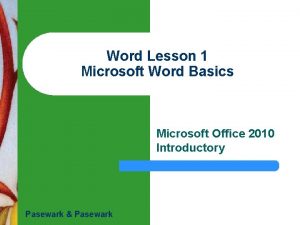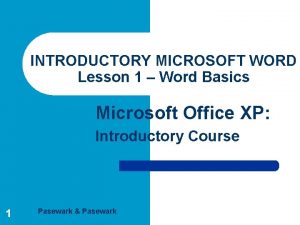Microsoft Word 2016 Lesson 7 Working with Themes




















































- Slides: 52

Microsoft Word 2016 Lesson 7 Working with Themes, Style Sets, Backgrounds, Quick Parts, and Text Boxes © 2016, John Wiley & Sons, Inc. Microsoft Official Academic Course, Microsoft Word 2016 1

Objectives © 2016, John Wiley & Sons, Inc. Microsoft Official Academic Course, Microsoft Word 2016 2

Software Orientation • Word provides options to change the appearance of a document by using preset, built-in formatting Style Sets, themes, and the document Formatting gallery. • You can customize theme colors, fonts, and effects. • You can also set the formatting as your default without having to reset it each time you work on a new document. • Paragraph Spacing allows you to quickly change the line and paragraph spacing to predefined values. • Changing a document’s background can also grab attention. © 2016, John Wiley & Sons, Inc. Microsoft Official Academic Course, Microsoft Word 2016 3

Formatting a Document with a Theme • Word provides features such as Themes to produce creative and professional-looking documents. • Predefined formatting preferences enable you to change the overall appearance of the document by selecting and applying a theme. • A document theme is a set of predefined formatting options that includes theme colors, fonts, and effects. © 2016, John Wiley & Sons, Inc. Microsoft Official Academic Course, Microsoft Word 2016 4

Step by Step: Format a Document with a Theme 1. OPEN the Hosting document and save it as Hosting Term. 2. On the Design tab, in the Document Formatting group, click Themes menu opens. 3. Click the View theme and the elements are applied to the document. Scroll down and view the changes in the document. 4. SAVE the document changes to the lesson folder on your flash drive. © 2016, John Wiley & Sons, Inc. Microsoft Official Academic Course, Microsoft Word 2016 5

Step by Step: Create and Customize a Document Color 1. USE the document that is open from the previous exercise. 2. On the Design tab, in the Document Formatting group, click the Colors button to open the Colors menu. 3. At the bottom of the Colors menu, click Customize Colors. The Create New Theme Colors dialog box appears (see right). © 2016, John Wiley & Sons, Inc. Microsoft Official Academic Course, Microsoft Word 2016 6

Step by Step: Create and Customize a Document Color 4. In the Name box, replace Custom 1 by typing Corporate [your initials]. 5. Click Save; the dialog box closes. You have defined a new custom theme color name based on default colors. 6. Click Colors and under the Custom section, place your insertion point over Corporate [your initials]. Right-click theme name and then click Edit. 7. In the list of theme colors, click the Accent 2 drop-down arrow to produce a menu of colors for this element. 8. Select Tan, Text 2, Darker 50%. 9. Click Save. You changed the default color and created your own custom theme colors for your document. 10. SAVE the document as Hosting Term 2. © 2016, John Wiley & Sons, Inc. Microsoft Official Academic Course, Microsoft Word 2016 7

Step by Step: Create and Customize a Document Font 1. USE the Hosting Term 2 document. 2. On the Design tab, in the Document Formatting group, click the Fonts button to display the Fonts menu. In the menu, click Customize Fonts. The Create New Theme Fonts dialog box appears. 3. In the Name box, replace Custom 1 by typing Corporate Fonts [your initials]. 4. Change the Heading Font and Body Font to Arial. Notice the preview of your font choices that appears in the Sample pane of the dialog box. 5. Click Save to close the dialog box and apply your font choices to the document. 6. SAVE the document as Hosting Term 3. © 2016, John Wiley & Sons, Inc. Microsoft Official Academic Course, Microsoft Word 2016 8

Step by Step: Create and Customize Document Effects 1. USE the Hosting Term 3 document. Position the insertion point anywhere in the document. 2. Click the Effects button and select Glossy from the menu that appears. The appearance of the shapes change based on the effect you have selected. Notice the change in the bevel shape in the figure below. 3. SAVE the document as Hosting Term 4. © 2016, John Wiley & Sons, Inc. Microsoft Official Academic Course, Microsoft Word 2016 9

Applying a Style Set to a Document • The Document Formatting group on the Design tab contains many different Style Sets that change the appearance of the whole document. • Style Sets are predefined collections of styles with fonts and paragraph spacing included. • Style Sets work with +Body and +Headings fonts. Each document has default heading and body fonts that are automatically assigned to the built-in styles. • If you use those built-in styles to format your document, you can change the fonts used in the document by either applying a different theme or theme fonts or by applying a different Style Set. © 2016, John Wiley & Sons, Inc. Microsoft Official Academic Course, Microsoft Word 2016 10

Applying a Style Set to a Document You can define your own Style Sets. To do so: 1. Format the document the way you want it, including your choice of heading and body fonts, paragraph indentation, and spacing settings for the built-in styles. 2. Open the Style Set gallery on the Design tab and click Save as a New Style Set. 3. In the Save as a New Style Set dialog box, assign a file name and then click Save. 4. Style Sets are saved as a template in the C: UsersusernameApp. DataRoamingMicrosoftQuick. Styles folder. After you save a Style Set, it appears in a Custom section in the Style Sets gallery. Right-click and choose Delete to delete it. © 2016, John Wiley & Sons, Inc. Microsoft Official Academic Course, Microsoft Word 2016 11

Step by Step: Apply a Style Set to a Document 1. USE the Hosting Term 4 document. 2. Hover the mouse over a few of the built-in Style Sets in the Document Formatting group and watch how the appearance of the document changes. 3. Click the More button and select Lines (Distinctive), under Built-In, in the second row, third column. 4. SAVE the document as Hosting Term 5. © 2016, John Wiley & Sons, Inc. Microsoft Official Academic Course, Microsoft Word 2016 12

Formatting a Document's Background Word’s enhanced features enable the user to produce a creatively formatted document by: • Changing the background color • Inserting a watermark • Adding a border to the document © 2016, John Wiley & Sons, Inc. Microsoft Official Academic Course, Microsoft Word 2016 13

Inserting a Page Color • Adding a background color to the title page of a report conveys originality. • It is important to use background colors in moderation and to choose a page color that will not interfere with the text. If the text is dark, for example, the background color should be light. If the text is light, a dark background would improve the document’s readability. • Word also lets you add interesting Fill Effects for the Page Background, such as gradients, textures, patterns, and pictures. © 2016, John Wiley & Sons, Inc. Microsoft Official Academic Course, Microsoft Word 2016 14

Step by Step: Insert a Page Color 1. USE the Hosting Term 5 document and click the Design tab. 2. In the Page Background group, click the Page Color button to open the Theme Colors menu and gallery (see right). 3. Click to select White, Background 1, Darker 5%. The page color is applied. 4. SAVE the document as Hosting Term 6. © 2016, John Wiley & Sons, Inc. Microsoft Official Academic Course, Microsoft Word 2016 15

Inserting a Watermark • In business, some documents might contain sensitive information, and the nature of a document’s status should be clearly conveyed on its pages. • Word provides built-in text called watermarks that display lightly behind text as words, such as confidential, draft, or urgent. • You can customize watermarks to include text or images, such as company logos. © 2016, John Wiley & Sons, Inc. Microsoft Official Academic Course, Microsoft Word 2016 16

Step by Step: Insert a Watermark 1. USE the Hosting Term 6 document. 2. In the Page Background group of the Design tab, click the Watermark menu and select Confidential 1. 3. The watermark is placed behind the text and is semitransparent. 4. SAVE the document as Hosting Term 7. © 2016, John Wiley & Sons, Inc. Microsoft Official Academic Course, Microsoft Word 2016 17

Step by Step: Insert a Custom Watermark 1. USE the Hosting Term 7 document and click the Watermark menu and select Custom Watermark. 2. Select the Text watermark option and in the Text drop-down menu, select Draft. 3. In the Font drop-down menu, select Franklin Gothic Book. This changes the text watermark font. 4. In the Color drop-down menu, select Dark Red (see right). 5. Click OK. The watermark is inserted on all pages. 6. SAVE the document as Hosting Term 8. © 2016, John Wiley & Sons, Inc. Microsoft Official Academic Course, Microsoft Word 2016 18

Step by Step: Insert an Image Watermark 1. USE the Hosting Term 8 document. 2. Remove the Page Color background by clicking the Page Color button and then selecting No Color. 3. Click the Watermark button and select Custom Watermark. The Printed Watermark dialog box opens. 4. Select the Picture watermark option and then click Select Picture. The Insert Pictures window appears. 5. In the From a file area, click Browse. The Insert Picture combo box appears. 6. Locate your lesson folder and select Internet Search. 7. Click Insert to insert the image into the document and then click OK to close the Printed Watermark dialog box. 8. SAVE the document as Hosting Term 9. © 2016, John Wiley & Sons, Inc. Microsoft Official Academic Course, Microsoft Word 2016 19

Step by Step: Remove a Watermark 1. USE the Hosting Term 10 document. 2. OPEN the Watermark menu and select Remove Watermark. 3. SAVE the document as Hosting Term 10. © 2016, John Wiley & Sons, Inc. Microsoft Official Academic Course, Microsoft Word 2016 20

Using Quick Parts in a Document • Building blocks contain built-in reusable content such as text, graphics, and objects. • They are easy to manage and insert in a document for a quick format. • Building blocks are organized in galleries and sorted by category. • In the Building Blocks gallery, you can insert cover pages, headers, footers, page numbers, text boxes, and watermarks. © 2016, John Wiley & Sons, Inc. Microsoft Official Academic Course, Microsoft Word 2016 21

Using Built-In Building Blocks • Building blocks are also called Auto. Text; you use both features the same way. • You can use predefined building blocks or create or customize your own. • The Building Blocks Organizer allows you to edit, delete or insert building blocks. • In the left pane of the dialog box, the built-in building blocks are listed by name. The right pane previews your selections. • The Gallery column indicates the gallery that contains each building block. • The Category column indicates each element’s general type. • The Template column indicates the template in which the element is stored. © 2016, John Wiley & Sons, Inc. Microsoft Official Academic Course, Microsoft Word 2016 22

Step by Step: Use Built-In Building Blocks 1. USE the Hosting Term 10 document. 2. On the Insert tab, in the Text group, click the Quick Parts button to display the Quick Parts menu. 3. Click Building Blocks Organizer to display the Building Blocks Organizer dialog box. 4. Click the Name heading to sort the building blocks by name. 5. Scroll down the list and select the Confidential 1 watermark. 6. Click the Insert button. The Confidential watermark appears behind the text on every page. 7. Position the insertion point at the beginning of the first paragraph under Introduction. © 2016, John Wiley & Sons, Inc. Microsoft Official Academic Course, Microsoft Word 2016 23

Step by Step: Use Built-In Building Blocks 8. Open the Building Blocks Organizer dialog box again. 9. Click the Gallery heading to sort the building blocks by gallery. 10. Scroll down and select Austin Quote from the Text Box gallery. Click Insert and a pull quote is inserted in the document as shown in below. You can type text in the placeholders or drag and drop text in the area. © 2016, John Wiley & Sons, Inc. Microsoft Official Academic Course, Microsoft Word 2016 24

Step by Step: Use Built-In Building Blocks 11. Under the heading, Introduction, select the second paragraph beginning with Questions or comments. . 12. Move the selected text inside the quote area by dragging and dropping. 13. Use the Show/Hide Editing Marks button to delete both line breaks after the first paragraph under Introduction. 14. Select the text box and the Layout Options button appears on the right side of the text box. 15. Click the Layout Options button to open the menu. The menu provides options for arranging the document text and the text box. 16. Click the See more link to open the Layout dialog box. © 2016, John Wiley & Sons, Inc. Microsoft Official Academic Course, Microsoft Word 2016 25

Step by Step: Use Built-In Building Blocks 17. Click the Text Wrapping tab and select Square. 18. Click the Left only option in the Wrap text section. Click OK. 19. Place your pointer on the text box border —the pointer changes to four arrows to allow you to drag and drop. Drag the quote to the end of the first paragraph until the last seven lines of the paragraph wrap around it. © 2016, John Wiley & Sons, Inc. Microsoft Official Academic Course, Microsoft Word 2016 26

Step by Step: Use Built-In Building Blocks 20. Press Ctrl+End to move the insertion point to the end of the document. 21. Open the Building Blocks Organizer dialog box. 22. Scroll down and select Motion Sidebar from the Text Box gallery. 23. Click Insert. The text box is inserted at the end of the document and positioned on the left side of the document. Your next step is to insert text into the text box. 24. Select the paragraph above Refusal of Service beginning with You and Flatland Hosting further agree. . . When selecting the paragraph, do not select the paragraph mark, because this will avoid displaying the horizontal line in the Text Box twice. © 2016, John Wiley & Sons, Inc. Microsoft Official Academic Course, Microsoft Word 2016 27

Step by Step: Use Built-In Building Blocks 25. Change the font color to white so that the text will be visible on the sidebar. 26. Drag and drop the selection in the text box. 27. At the top of the text box, delete the [Sidebar Title] placeholder and blank line to move the text up one line. 28. SAVE the document as Hosting Term 11. © 2016, John Wiley & Sons, Inc. Microsoft Official Academic Course, Microsoft Word 2016 28

Step by Step: Insert a Cover Page Using the Built-In Building Blocks 1. USE the Hosting Term 11 document. 2. Open the Building Blocks Organizer dialog box and select Whisp in the Cover Pages gallery. 3. Click Insert. The cover page is inserted as page 1. 4. Type the following information in the placeholders: Year: 20 XX (Select current date or type the year. ) Document Title: Flatland Hosting Company Document Subtitle: Guidelines & Agreements Author Name: A. Becker 5. Remove the placeholder for the Company Name. 6. SAVE the document as Hosting Term 12. © 2016, John Wiley & Sons, Inc. Microsoft Official Academic Course, Microsoft Word 2016 29

Creating and Copying Building Blocks • Create your own building blocks to store any text that you use frequently. For example, signature lines that contain your name, title, and company name. • When deciding where to store building blocks, consider whether you will want to share them with others and whether you want them available for all documents. • New building blocks that you create in Word are stored by default in the Building Blocks. dotx file. • This template is automatically enabled all the time, so the building blocks you store there will be available. • You can choose to store building blocks in the active template if you prefer. © 2016, John Wiley & Sons, Inc. Microsoft Official Academic Course, Microsoft Word 2016 30

Creating and Copying Building Blocks • Share your Building Blocks. dotx file with other users on the same computer by copying it from the C: UsersusernameApp. DataRoamingMicrosoftDocument Building Blocks103315 folder and then pasting it into the corresponding user folder for another user account. • Share the Building Blocks. dotx file with users on different computers by emailing them the file or providing it on a disc or flash drive. • Make sure you give the recipients instructions about where to store the file, so that Word will recognize and use it. © 2016, John Wiley & Sons, Inc. Microsoft Official Academic Course, Microsoft Word 2016 31

Step by Step: Create and Copy Building Blocks 1. OPEN a new blank Word document and Type the following signature block, pressing Shift+Enter between each line: Andrew Cencini General Manager Flatland Hosting 2. Select all three lines in the signature block. 3. On the Insert tab, in the Text group, click Quick Parts and then click Save Selection to Quick Part Gallery. 4. In the Name box of the Create New Building Block dialog box, type Cencini Signature. 5. Select Building Blocks in the Save in box. 6. Click the Options drop-down list and choose Insert content in its own paragraph. © 2016, John Wiley & Sons, Inc. Microsoft Official Academic Course, Microsoft Word 2016 32

Step by Step: Create and Copy Building Blocks 7. Click OK and close the document without saving your changes. 8. Close Word. When prompted whether or not to save the changes to Building Blocks, click Save. 9. In File Explorer, navigate to the C: UsersusernameApp. DataRoamingMicrosoftDocument Building Blocks103316 folder, where username is your user account. 10. Select the Building Blocks file and press Ctrl+C to copy the file to the Clipboard. 11. Press Ctrl+V to paste a copy of the file in the same folder. 12. Rename the file Blocks Copy. To rename the file, press F 2, type the new name, and then press Enter. © 2016, John Wiley & Sons, Inc. Microsoft Official Academic Course, Microsoft Word 2016 33

Step by Step: Create and Copy Building Blocks 13. Select Blocks Copy and press Ctrl+C to copy the file to the Clipboard. 14. Navigate to the folder that your instructor has told you to use for this exercise. 15. Press Ctrl+V to paste the file into the new location. 16. Navigate to the lesson folder on your flash drive and press Ctrl+V to paste a copy of the Blocks Copy file there. © 2016, John Wiley & Sons, Inc. Microsoft Official Academic Course, Microsoft Word 2016 34

Inserting an Equation • Microsoft Word 2016 has built-in equations, which you can insert from the Quick Parts gallery or by using the Equation command. • When you create a table that contains values, you can calculate your answer by inserting an equation. • You can use the Equation Tools Design tab, which appears when you insert an equation into a document, to edit or construct your own equation. © 2016, John Wiley & Sons, Inc. Microsoft Official Academic Course, Microsoft Word 2016 35

Step by Step: Insert an Equation 1. LAUNCH Word and OPEN a new blank Word document. 2. Open the Quick Parts menu and then click Building Blocks Organizer. 3. In the Building Blocks Organizer dialog box, in the Equations gallery, locate and click the Expansion of a Sum equation. 4. Click Insert. The Expansion of a Sum equation is inserted in the document. 5. Position the insertion point after the equation placeholder and then press the Enter key twice to place a blank line below the placeholder. 6. Open the Building Blocks Organizer dialog box, locate and click the Area of Circle equation and then click Insert. © 2016, John Wiley & Sons, Inc. Microsoft Official Academic Course, Microsoft Word 2016 36

Step by Step: Insert an Equation 7. Position the insertion point after the equation placeholder and then press the Enter key twice to place a blank line below the placeholder. 8. Open the Building Blocks Organizer dialog box, then locate and click the Binomial Theorem equation. 9. Click Insert. 10. Click after the equation placeholder and press the Enter key twice. 11. SAVE the document as Equations. © 2016, John Wiley & Sons, Inc. Microsoft Official Academic Course, Microsoft Word 2016 37

Inserting a Field from Quick Parts • A field is a placeholder that Word uses to insert content into a document. • Word automatically uses fields when specific commands are activated, such as those for inserting dates, formulas, page numbers, and a table of contents. • When you insert a date field in a document, the date is updated automatically each time the document is opened. • Fields, also called field codes, appear between curly brackets ({ }) when displayed. • Field codes are off by default. To display field codes and toggle between display text and field codes press Alt+F 9. • To edit a field, place the insertion point within the field, rightclick, and then click Edit Field. © 2016, John Wiley & Sons, Inc. Microsoft Official Academic Course, Microsoft Word 2016 38

Step by Step: Insert the Date and Time 1. OPEN the Billing Table document from the lesson folder. 2. Position the insertion point in the last cell of the table in the second column. 3. Press Tab to insert a new row. Pressing the Tab key advances the insertion point to the next cell. If you are in the last cell of the table, it inserts a row. 4. Position the insertion point in the first column, fifth row. Type Total and align right. 5. Press Tab. This time, the next cell is selected. 6. On the Insert tab, in the Text group, click the Quick Parts button to open the menu. 7. Click Field on the menu. The Field dialog box appears. © 2016, John Wiley & Sons, Inc. Microsoft Official Academic Course, Microsoft Word 2016 39

Step by Step: Insert the Date and Time 8. The default = (Formula) is selected in the Field names box. Click the Formula button. The Formula dialog box appears. 9. Change the Number Format by selecting the third option in the drop-down list. Click OK. 10. Place the insertion point on the blank line below the table and press Enter three times. 11. Type Last Updated: in bold and press the spacebar once after the colon. 12. On the Insert tab, in the Text group, click the Quick Parts button and click Field on the menu. 13. In the Field dialog box, in the Categories drop-down list, select Date and Time. 14. In the Field Names list, click Date. © 2016, John Wiley & Sons, Inc. Microsoft Official Academic Course, Microsoft Word 2016 40

Step by Step: Insert the Date and Time 15. In the Date Formats list, select the ninth option with the Day Month Year format. d MMMM yyyy appears in the Date Formats box. These symbols represent how the date will look in your document. 16. Click OK to close the dialog box and insert the date and time field in your document. 17. The document should look similar to the one shown in the figure. 18. Disable the Show/Hide Editing Marks button. 19. SAVE the document as Billing Update. © 2016, John Wiley & Sons, Inc. Microsoft Official Academic Course, Microsoft Word 2016 41

Software Orientation • Before you begin working with text boxes, it is a good idea to become familiar with the new tools available in the Ribbon. When you insert a text box, the Drawing Tools - Format tab appears in the Ribbon. • The Drawing Tools - Format tab provides commands for editing text boxes. © 2016, John Wiley & Sons, Inc. Microsoft Official Academic Course, Microsoft Word 2016 42

Applying and Manipulating Text Boxes • A text box is a formatted box in which you can insert and position text and/or graphic objects. • You can use text boxes for a variety of purposes. Most often, they are used to insert text within a document, for specific emphasis or visual interest. • After you insert a text box, you can format the box using the Drawing Tools. • You can also format the text in the box using the Font formats. • A pull quote is a small selection of text that is pulled out or quoted from a larger text. It is displayed in a box on the page that is formatted for emphasis, often using drop caps, as in newsletters, advertisements, and magazines. © 2016, John Wiley & Sons, Inc. Microsoft Official Academic Course, Microsoft Word 2016 43

Inserting a Text Box • Word provides a gallery of built-in text boxes with pull quotes and sidebars, which you can insert in a document. • When you need a different kind of text box, you can draw and insert your own empty, unformatted text box. • When drawing a text box, the Layout Options provide the ability to wrap text around the box. © 2016, John Wiley & Sons, Inc. Microsoft Official Academic Course, Microsoft Word 2016 44

Step by Step: Insert a Text Box 1. OPEN the Hosting document from the data files for this lesson. 2. Position the insertion point after the first paragraph after the Introduction heading. 3. On the Insert tab, in the Text group, click the Text Box button. A menu of built-in quote and sidebar text box styles appears. 4. Click the Simple Text Box option. The text box, containing placeholder text, appears in the first paragraph. 5. Select the second paragraph beginning with Questions or comments. . com and drag and drop it in the text box. The Layout Options button appears to the right of the text box. © 2016, John Wiley & Sons, Inc. Microsoft Official Academic Course, Microsoft Word 2016 45

Step by Step: Insert a Text Box 6. Click the Layout Options button to open the Layout Options menu. 7. In the With Text Wrapping section, select Tight. The text box wraps tightly around the paragraph. You also have the option to type text in the text box. 8. Delete one of the line breaks after the first paragraph. 9. Press Ctrl+End to go to the end of the document. 10. On the Insert tab, in the Text group, click the Text Box button and then select Draw Text Box. A crosshair (+) appears. 11. Press and hold the left mouse button to draw a text box in the blank line below the last paragraph under the Refusal of Service heading. © 2016, John Wiley & Sons, Inc. Microsoft Official Academic Course, Microsoft Word 2016 46

Step by Step: Insert a Text Box 12. Use the Size group in the Drawing Tools - Format tab to change the width and height to 2. 22” wide and. 95” in height. 13. Select the first sentence under the Refusal of Service heading beginning with Flatland Hosting. . . no refunds and drag and drop it into the text box. 14. Press Ctrl+E to center the text in the text box. 15. Click the Layout Options button to open the Layout Options menu. 16. In the With Text Wrapping section, select Top and Bottom. © 2016, John Wiley & Sons, Inc. Microsoft Official Academic Course, Microsoft Word 2016 47

Step by Step: Insert a Text Box 17. Select the edge of the text box until you see the Move arrow. Then move the text box to the right, to center it horizontally on the page. Use the ruler as your guide. Your document should resemble the figure below. 18. SAVE the document as Hosting Term 13. © 2016, John Wiley & Sons, Inc. Microsoft Official Academic Course, Microsoft Word 2016 48

Inserting Special Characters • The Text group in Word lets you insert special characters using the Symbol command on the Ribbon, the Symbol dialog box, or keyboard shortcuts. • Special characters include recognizable symbols that people use to differentiate their products or services. • Copyright © symbols are used to protect content and • Trademark™ is an unregistered trademark used to promote a company’s goods. • Other symbols include fractions ½, em dashes (—), and more. • Depending on the font in use, you can insert international monetary symbols such as the pound sign, £, or yen sign, ¥. These symbols are represented by Unicode, which is a character code. © 2016, John Wiley & Sons, Inc. Microsoft Official Academic Course, Microsoft Word 2016 49

Step by Step: Insert Special Characters 1. USE the Hosting Term 13 document. 2. Press Ctrl+End to move to the end of the document. 3. Press Enter once after the last paragraph under the heading, Refusal of Service. 4. Type Copyright Flatland Hosting 2016. All Rights Reserved. 5. Place the insertion point after the t in Copyright and press the Spacebar once. 6. On the Insert tab, in the Symbols group, click the Symbol button and then click More Symbols. The Symbol dialog box appears. © 2016, John Wiley & Sons, Inc. Microsoft Official Academic Course, Microsoft Word 2016 50

Step by Step: Insert Special Characters 7. Click the Special Characters tab, as shown in below. 8. Select Copyright from the list and click Insert. 9. Click Close. The copyright symbol is inserted in front of the company name followed by the year this document was created. 10. SAVE your document as Hosting Final. © 2016, John Wiley & Sons, Inc. Microsoft Official Academic Course, Microsoft Word 2016 51

Skill Summary © 2016, John Wiley & Sons, Inc. Microsoft Official Academic Course, Microsoft Word 2016 52
 Microsoft official academic course microsoft word 2016
Microsoft official academic course microsoft word 2016 Microsoft official academic course microsoft word 2016
Microsoft official academic course microsoft word 2016 Microsoft official academic course microsoft excel 2016
Microsoft official academic course microsoft excel 2016 Smart work and hard work
Smart work and hard work Hot and cold forming
Hot and cold forming Hot working and cold working difference
Hot working and cold working difference Machining operations
Machining operations Examples of cold working and hot working
Examples of cold working and hot working Capolettera word
Capolettera word Exploring microsoft office 2016
Exploring microsoft office 2016 Exploring microsoft office excel 2016 comprehensive
Exploring microsoft office excel 2016 comprehensive Excel lesson 4 vocabulary
Excel lesson 4 vocabulary Microsoft office 2016 in practice
Microsoft office 2016 in practice Microsoft threat modeling tool
Microsoft threat modeling tool Microsoft excel 2016 basics vocabulary
Microsoft excel 2016 basics vocabulary Offico365
Offico365 Standard toolbar in ms word 2010
Standard toolbar in ms word 2010 Interfaz de word 2016
Interfaz de word 2016 Backstage view word 2016
Backstage view word 2016 Ms word latest version
Ms word latest version Smallest typable character
Smallest typable character Microsoft word memo
Microsoft word memo Macros in word 2016
Macros in word 2016 How to unlink subdocuments in word
How to unlink subdocuments in word Word 2016 session 2 post assessment
Word 2016 session 2 post assessment Backstage word 2016
Backstage word 2016 Word 2016 freihandtools aktivieren
Word 2016 freihandtools aktivieren Como colocar borda no word 2016
Como colocar borda no word 2016 Widows and orphans word 2016
Widows and orphans word 2016 Lesson 3: working with ratios and proportion
Lesson 3: working with ratios and proportion Lesson 2 working for a cause
Lesson 2 working for a cause Windows startwarren theverge
Windows startwarren theverge Microsoft excel merupakan program aplikasi …. *
Microsoft excel merupakan program aplikasi …. * Word processing activity 1
Word processing activity 1 Word for picture puzzle
Word for picture puzzle Bingo template word
Bingo template word Microsoft word adalah software yang diproduksi oleh
Microsoft word adalah software yang diproduksi oleh Ambiente de word
Ambiente de word Microsoft word notes
Microsoft word notes Qka eshte wordi
Qka eshte wordi Microsof word adalah perangkat lunak pengolah
Microsof word adalah perangkat lunak pengolah Microsoft word 2014
Microsoft word 2014 Microsoft word 2007 dapat dijalankan dengan menggunakan
Microsoft word 2007 dapat dijalankan dengan menggunakan Langkah langkah memulai microsoft word
Langkah langkah memulai microsoft word Barra de estado en word
Barra de estado en word Indice en word 2007
Indice en word 2007 Desventajas de microsoft project
Desventajas de microsoft project Edytor tekstu ms word
Edytor tekstu ms word Microsoft word 2009
Microsoft word 2009 Slide todoc.com
Slide todoc.com Which microsoft word tab contains the print command? *
Which microsoft word tab contains the print command? * Office microsoft
Office microsoft Menu bar title bar
Menu bar title bar








